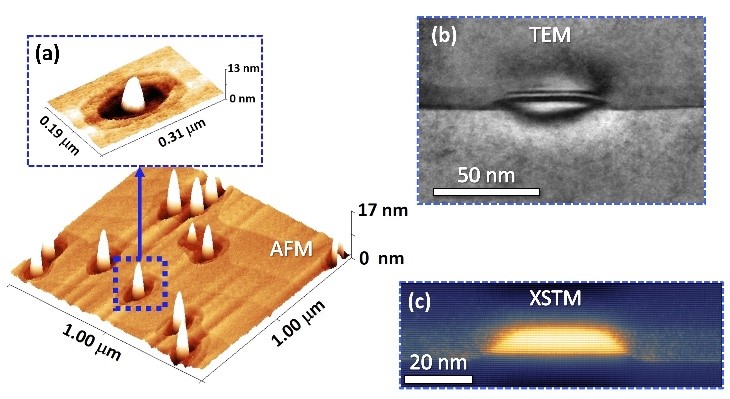Droplet Epitaxy
Droplet Epitaxy (DE) is an epitaxial technique, mostly used for III-V semiconductors, for the fabrication of a variety of nanostructures, such as Quantum Dots (QDs), Quantum Rings (QRs), and nanoholes. It relies on the spontaneous formation of group III metallic droplets, which are subsequently crystallized into QDs by the supply of a group V source material. DE was initially discovered and developed in Molecular Beam Epitaxy (MBE) by Koguchi et al. [1] in 1991. It is a flexible epitaxial technique as it does not rely on the lattice-mismatch between substrate and epilayer, as it is usually the case for the Stranski-Krastanov (SK) method. III-V DE QDs find applications particularly as efficient sources of pure single photons and entangled photon pairs, and can be easily integrated into photonic chips, thus representing the building blocks for future quantum networks [2].
Challenge
The fabrication of nanostructures by DE, particularly QDs, has been subject of extensive studies by MBE in the last decades [3]. DE has proved to be a successful epitaxial technique for realising QDs with high compositional homogeneity, reduced strain, and high in-plane symmetry, resulting in a strongly reduced fine-structure splitting (FSS) up to 4 ?eV for short wavelength QD systems such as GaAs/AlGaAs [3]. Such properties make DE QDs excellent candidates for a variety of applications, particularly as quantum emitters for quantum secure communication and quantum key distribution (QKD).Although there is a variety of studies on DE in MBE, challenges remain in transferring such technology to industry for full reproducibility and large-scale fabrication of high-quality DE QDs, especially at longer wavelengths of the telecom C-band. Additionally, other aspects as a precise control of the location and size of quantum dots are the subject of ongoing research.
Solution
Only recently, DE growth of high-quality III-V QDs has been demonstrated by Metal-Organic Vapour Phase Epitaxy (MOVPE), the cost-effective and industrially compatible epitaxial technique. In particular, the development of DE in MOVPE of InAs/InP QDs compatible with the telecom window has been carried out by researchers at the National Epitaxy Facility (NEF). Such QDs have shown a smaller FSS compared with SK QDs and has led to the demonstration of the first quantum light-emitting diode (QLED) operating at around 1.55 ?m at temperatures up to 93 K [4], and later also enabled teleportation of qubits [5].
Further epitaxial developments have led to the demonstration of the growth of telecom InAs/InP QDs on the industrially-compatible 3×2’’ close-coupled showerhead (CCS) Aixtron MOVPE ‘JR’ reactor of the NEF [6-9], allowing for a technology transfer into industry and on ongoing studies on their reproducibility. Such QDs exhibit high optical quality with reproducible single-dot emission at low-temperatures with a reduced linewidth down to ~30 ?eV. Noticeably, DE allows for the tuning of the QD emission over a broad range of wavelengths, ranging from the O- to the L-band.

At the National Epitaxy Facility, we have been developing Droplet Epitaxy over the last decade, exploring it especially via MOVPE, deepening the understanding of this method. We have developed DE QDs at telecom wavelengths particularly for the material system InAs/InP. DE QDs have also been incorporated in devices with unique and record performances, underpinning a variety of research grants and industrial support. Key factors allowing the National Epitaxy Facility to have a leading position in this technology are:
- Both MOVPE and MBE available for Droplet Epitaxy quantum dot growth
- Established growth procedures for key growth parameters ensuring reproducibility and continuous improvement
- The availability of in-house excellent electrical, optical and structural characterisation facilities and close and collaborative working with customers allowing for the optimisation of growth and targeted properties for the quantum dots further developing the field
- Full fabrication facilities for devices and structures that enhance the properties of DE Quantum Dots
- Notable achievements on DE QDs by MOVPE: InAs/InP QDs with densities from 108 cm-2 to 1010 cm-2. The low QD densities are most suitable for single dot spectroscopy and Quantum Communication Technologies. Single-dot emission with linewidths down to ~30 ?eV. Higher QD density instead suitable for laser development at telecom wavelengths
Conclusion
The National Epitaxy Facility has been developing expertise and capability in Droplet Epitaxy applied to quantum dot science and technology that is available to researchers and industrial customers in the UK. The National Epitaxy Facility continues to work with academic partners and external collaborators developing the technology further for both fundamental studies and applications. New directions include extending wavelengths using new materials in the Droplet Epitaxy process and, at the same time, controlling shape, size and positioning of Quantum Dots through fundamental study of the growth dynamics towards advancements of Quantum Communication Technologies.
References
[1] N. Koguchi, S. Takahashi, T. Chikyow, J. Cryst. Growth, 111, 688 (1991)
[2] P. Michler, Quantum Dots for Quantum Information Technologies, Springer, Berlin/New York (2017)
[3] M. Gurioli, Z. Wang, A. Rastelli, T. Kuroda, S. Sanguinetti, Nat. Mater. 18, 799 (2019)
[4] T. Müller, J. Skiba-Szymanska, A. B. Krysa, J. Huwer, M. Felle, M. Anderson, R. M. Stevenson, J. Heffernan, D. A. Ritchie, A. J. Shields, Nat. Comm. 9, 862 (2018)
[5] M. Anderson, T. Müller, J. Skiba-Szymanska, A. B. Krysa, D. A. Ritchie, A. J. Shields, Appl. Phys. Lett. 118014003 (2021)
[6] E. M. Sala, Y. I. Na, M. Godsland, A. Trapalis, J. Heffernan, Phys. Status Solidi RRL 142000173 (2020)
[7] E. M. Sala, M. Godsland, Y. I. Na, A. Trapalis, J. Heffernan, Nanotechnology 33, 065601 (2022)
[8] E. M. Sala, M. Godsland, A. Trapalis, J. Heffernan, Phys. Status Solidi RRL 15, 2100283 (2021)
[9] R.S.R. Gajjela, E.M. Sala, J. Heffernan, P. Koenraad, ACS Appl. Nano Mater. 6, 8070 (2022)
Download a pdf version:
Case study – Droplet Epitaxy
